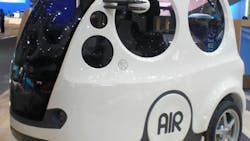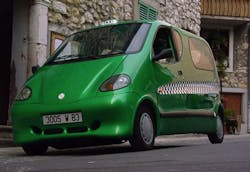As editor of Hydraulics & Pneumatics, one of my roles is to be promote the increased use of fluid power technologies. But I'm sorry, I just can't get behind the concept of using compressed air as a practical means of driving a car.
A golf cart? Maybe. But you just can't store enough compressed air to give a car any appreciable range. I haven't crunched the numbers, but this video explains that one of the leading air car prototypes uses three cylinders of compressed air at 300 bar (roughly 4350 psi). The cylinders are made of a carbon fiber composite for light weight. The car's engine and frame are made primarily of aluminum, also for light weight. The video doesn't mention how safe such a vehicle would be in a collision. The host does mention that the composite cylinders would be safer than steel ones, but I wouldn't want to be anywhere near that much stored energy being released in an instant.
You'd still need some sort of variable transmission to provide enough torque for decent acceleration from rest and also provide enough rotational speed for highway travel without gobbling up all the compressed air within a few miles. And don't forget, you'd need electricity for lights and such, so you'd have to tap into the compressed air to drive a generator — another drain on range.
The host mentions that the air car might incorporate a small internal combustion engine to increase acceleration. This implies that the vehicle would be more of a dog than the '63 Corvair I had as a teenager. (That thing wouldn't even burn rubber on wet leaves.) The website of MDI Enterprises mentions that some versions of the air car would incorporate an internal combustion engine for highway driving. Again, this confirms that a car powered by air alone cannot meet the requirements of today's typical car.
And of course, the energy needed to compress the air or nitrogen into the storage cylinder would be substantial. So unless the compressor was powered by solar, wind, or other type of clean energy, a compressed air car wouldn't be as environmentally friendly as it might seem.
Compressed air will continue to be a clean, safe, and practical means of factory automation. However, I think it's primary role in the drive train of cars will be limited to the insides of tires.
About the Author
Alan Hitchcox Blog
Editor in Chief
Alan joined Hydraulics & Pneumatics in 1987 with experience as a technical magazine editor and in industrial sales. He graduated with a BS in engineering technology from Franklin University and has also worked as a mechanic and service coordinator. He has taken technical courses in fluid power and electronic and digital control at the Milwaukee School of Engineering and the University of Wisconsin and has served on numerous industry committees.

Leaders relevant to this article:

